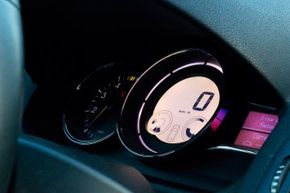Easier Design and Manufacturing
Having communication standards has made designing and building cars a little easier. A good example of this simplification is the car's instrument cluster.
The instrument cluster gathers and displays data from various parts of the vehicle. Most of this data is already used by other modules in the car. For instance, the ECU knows the coolant temperature and engine speed. The transmission controller knows the vehicle speed. The controller for the anti-lock braking system (ABS) knows if there is a problem with the ABS.
Advertisement
All of these modules simply send this data onto the communications bus. Several times a second, the ECU will send out a packet of information consisting of a header and the data. The header is just a number that identifies the packet as either a speed or a temperature reading, and the data is a number corresponding to that speed or temperature. The instrument panel contains another module that knows to look for certain packets -- whenever it sees one, it updates the appropriate gauge or indicator with the new value.
Most carmakers buy the instrument clusters fully assembled from a supplier, who designs them to the carmaker's specifications. This makes the job of designing the instrument panel a lot easier, both for the carmaker and the supplier.
It is easier for the carmaker to tell the supplier how each gauge will be driven. Instead of having to tell the supplier that a particular wire will provide the speed signal, and it will be a varying voltage between 0 and 5 V, and 1.1 V corresponds to 30 mph, the carmaker can just provide a list of the packets of data. Then, it is the carmaker's responsibility to make sure that the correct data is output onto the communications bus.
It is easier for the supplier to design the instrument panel because he doesn't need to know any details of how the speed signal is generated, or where it's coming from. Instead, the instrument panel simply monitors the communications bus and updates the gauges when it receives new data.
These types of communications standards make it very uncomplicated for carmakers to outsource the design and manufacture of components: The carmaker doesn't have to worry about the details of how each gauge or light is driven, and the supplier who makes the instrument panel doesn't have to worry about where the signals are coming from.
